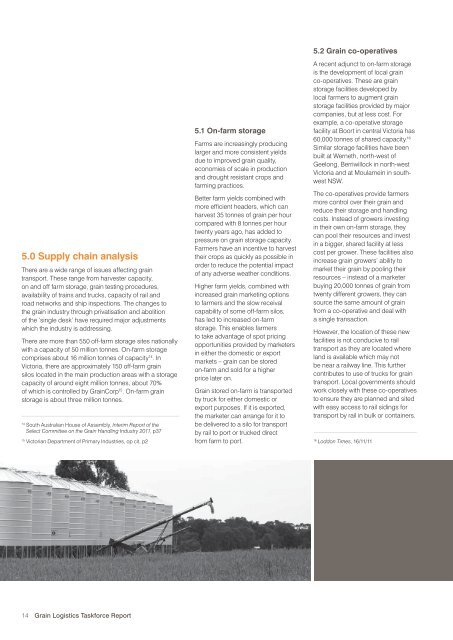5.0 Supply chain analysisThere are a wide range <strong>of</strong> issues affecting graintransport. These range from harvester capacity,on and <strong>of</strong>f farm storage, grain testing procedures,availability <strong>of</strong> trains and trucks, capacity <strong>of</strong> rail androad networks and ship inspections. The changes tothe grain industry through privatisation and abolition<strong>of</strong> the ‘single desk’ have required major adjustmentswhich the industry is addressing.There are more than 550 <strong>of</strong>f-farm storage sites nationallywith a capacity <strong>of</strong> 50 million tonnes. On-farm storagecomprises about 16 million tonnes <strong>of</strong> capacity 14 . InVictoria, there are approximately 150 <strong>of</strong>f-farm grainsilos located in the main production areas with a storagecapacity <strong>of</strong> around eight million tonnes, about 70%<strong>of</strong> which is controlled by <strong>Grain</strong>Corp 15 . On-farm grainstorage is about three million tonnes.14South Australian House <strong>of</strong> Assembly, Interim <strong>Report</strong> <strong>of</strong> theSelect Committee on the <strong>Grain</strong> Handling Industry 2011, p375.1 On-farm storageFarms are increasingly producinglarger and more consistent yieldsdue to improved grain quality,economies <strong>of</strong> scale in productionand drought resistant crops andfarming practices.Better farm yields combined withmore effi cient headers, which canharvest 35 tonnes <strong>of</strong> grain per hourcompared with 8 tonnes per hourtwenty years ago, has added topressure on grain storage capacity.Farmers have an incentive to harvesttheir crops as quickly as possible inorder to reduce the potential impact<strong>of</strong> any adverse weather conditions.Higher farm yields, combined withincreased grain marketing optionsto farmers and the slow receivalcapability <strong>of</strong> some <strong>of</strong>f-farm silos,has led to increased on-farmstorage. This enables farmersto take advantage <strong>of</strong> spot pricingopportunities provided by marketersin either the domestic or exportmarkets – grain can be storedon-farm and sold for a higherprice later on.<strong>Grain</strong> stored on-farm is transportedby truck for either domestic orexport purposes. If it is exported,the marketer can arrange for it tobe delivered to a silo for transportby rail to port or trucked directfrom farm to port.5.2 <strong>Grain</strong> co-operativesA recent adjunct to on-farm storageis the development <strong>of</strong> local grainco-operatives. These are grainstorage facilities developed bylocal farmers to augment grainstorage facilities provided by majorcompanies, but at less cost. Forexample, a co-operative storagefacility at Boort in central Victoria has60,000 tonnes <strong>of</strong> shared capacity. 16Similar storage facilities have beenbuilt at Werneth, north-west <strong>of</strong>Geelong, Berriwillock in north-westVictoria and at Moulamein in southwestNSW.The co-operatives provide farmersmore control over their grain andreduce their storage and handlingcosts. Instead <strong>of</strong> growers investingin their own on-farm storage, theycan pool their resources and investin a bigger, shared facility at lesscost per grower. These facilities alsoincrease grain growers’ ability tomarket their grain by pooling theirresources – instead <strong>of</strong> a marketerbuying 20,000 tonnes <strong>of</strong> grain fromtwenty different growers, they cansource the same amount <strong>of</strong> grainfrom a co-operative and deal witha single transaction.However, the location <strong>of</strong> these newfacilities is not conducive to railtransport as they are located whereland is available which may notbe near a railway line. This furthercontributes to use <strong>of</strong> trucks for graintransport. Local governments shouldwork closely with these co-operativesto ensure they are planned and sitedwith easy access to rail sidings fortransport by rail in bulk or containers.15Victorian <strong>Department</strong> <strong>of</strong> Primary Industries, op cit, p216Loddon Times, 16/11/1114 <strong>Grain</strong> <strong>Logistics</strong> <strong>Taskforce</strong> <strong>Report</strong>
5.3 Off-farm transportTrucks are used to transport grainfrom farms to silos or direct to portfor export depending on marketers’arrangements with growers. Somemarketers prefer to truck grain directto port to by-pass the storage andtransport systems <strong>of</strong> the larger bulkhandlers. Trucking grain direct toport also avoids queues at silosalthough this can cause queuing atports instead. Lack <strong>of</strong> coordinationbetween truck loading at farm orsilo and delivery to port can alsolead to truck queues.Truck queues also occur whensilos have slow and ineffi cientloading capability which increasesgrain transport costs because<strong>of</strong> underutilisation <strong>of</strong> truckstransporting grain. Whether a graintruck’s destination is a silo or port,there is a need for adequate truckparking and rest areas in towns andon major transport routes to ensureconsignors, truck owners and driversdo not breach chain <strong>of</strong> responsibilityrequirements with regard to drivinghours, rest and fatigue management.Industry has commented that this isparticularly a problem for grain trucksusing the <strong>Grain</strong>Corp facility at thePort <strong>of</strong> Geelong. There appears tobe a signifi cant mismatch betweenthe loading <strong>of</strong> trucks at silos andtheir scheduled time at the port,leading to truck queuing and fatiguemanagement concerns.In recognition <strong>of</strong> these issues,work is underway by industry tointroduce more effi cient informationvisibility, notifi cation and scheduling(timeslotting) between trucks loadingat silos and delivering to ports.These initiatives should lead to bettercoordination <strong>of</strong> truck arrivals andtruck management, resulting in moreeffi cient and reliable grain deliveryto port.The truck queuing problem ismanaged at the Port <strong>of</strong> Portlandthrough provision by <strong>Grain</strong>Corp <strong>of</strong> an<strong>of</strong>f-port truck marshalling area. Truckdrivers can wait there with full restprovisions until they are required atthe port which reduces truck queuesat the port and truck driver fatigue.However, there is no similar truckmarshalling facility near the Ports<strong>of</strong> Melbourne or Geelong.One potential way to address theissue <strong>of</strong> truck coordination is for themajor grain marketers to establisha transport committee similar tothat established in South Australiaby Viterra. This industry committeecomprises the South AustralianRoad <strong>Transport</strong> Association, the<strong>Department</strong> <strong>of</strong> <strong>Transport</strong>, Energyand Infrastructure, Owner DriversAssociation <strong>of</strong> SA, Livestock Ruralcarriers Association <strong>of</strong> SA andindividual carriers and meets threeto four times per year to providefeedback and initiatives for Viterrato consider on transport relatedissues. It also provides Viterra afurther opportunity to consult withthe industry on its proposed actions.Silo opening hours also affect theeffi ciency <strong>of</strong> <strong>of</strong>f-farm storage. Themajority <strong>of</strong> <strong>Grain</strong>Corp country silosgenerally operate from 8am to 3-4pm which limits the daily amount <strong>of</strong>grain that trucks can deliver to a site.Silo rationalisation and increaseddistance to silos, with no change insilo operating hours, has resulted indecreased truck utilisation because<strong>of</strong> fewer truck trips per day to eachsilo. <strong>Grain</strong> truck utilisation is furtherreduced through congestion at eithera silo or port. Sometimes grain trucksmiss silo opening hours and have towait overnight, with limited amenitiesfor drivers, until the silo opens the next day. Longer siloopening hours would alleviate this problem, but therehave been problems in fi nding enough labour to enablethis to occur.<strong>Grain</strong> testing and segregation also affects the grainsupply chain. <strong>Grain</strong> can be tested at a country siloand accepted, only to be rejected at the port receivalpoint. <strong>Grain</strong> rejected at the port must be returned to itsoriginating silo or an intermediate location. Increasedconsistency in grain sampling and testing procedures isconsidered to be a critical factor in improving both theeffi ciency <strong>of</strong> the grain handling system and providingmore consistent prices to growers.5.4 Local roadsThe increase in on-farm storage and greater use<strong>of</strong> trucks for grain transport has led to a signifi cantdeterioration in the condition <strong>of</strong> local roads with adverseeffects on road safety and road user amenity. For grainstored <strong>of</strong>f-farm, closure <strong>of</strong> small, ineffi cient rail siloshas worsened the problem <strong>of</strong> damage to local roadsby requiring grain to be transported by truck further tobigger rail silos or by road to ports.Maintenance <strong>of</strong> local roads is the responsibility <strong>of</strong>local governments. However, local governments areconcerned that they do not have suffi cient funds torepair and maintain roads damaged by increasingheavy truck traffi c using more local roads because<strong>of</strong> increased on-farm grain storage. In recognition <strong>of</strong>the funding shortfall regional local governments havein maintaining their roads, in October 2011 the StateGovernment provided funding <strong>of</strong> $160 million over fouryears to regional local governments for maintenance <strong>of</strong>local roads. 17Concern about local road funding is refl ected in thecampaign by local governments after the NationalLocal Roads and <strong>Transport</strong> Congress in Mt Gambierin November 2011. Local governments have called formore funding for community roads and bridges andfor continuation <strong>of</strong> the Federal Government’s Roadsto Recovery program for funding <strong>of</strong> local roads, whichcomprise more than 80% <strong>of</strong> the nation’s road network. 1817National Party press release 29/10/1118Stawell Times News, 6/12/11<strong>Grain</strong> <strong>Logistics</strong> <strong>Taskforce</strong> <strong>Report</strong> 15
















